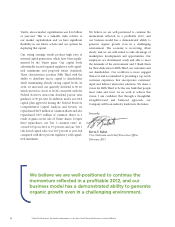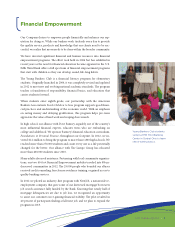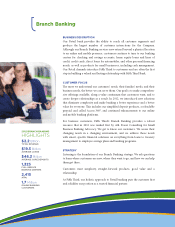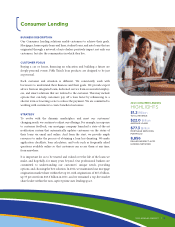Fifth Third Bank 2012 Annual Report Download - page 18
Download and view the complete annual report
Please find page 18 of the 2012 Fifth Third Bank annual report below. You can navigate through the pages in the report by either clicking on the pages listed below, or by using the keyword search tool below to find specific information within the annual report.
MANAGEMENT’S DISCUSSION AND ANALYSIS OF FINANCIAL CONDITION AND RESULTS OF OPERATIONS
16 Fifth Third Bancorp
OVERVIEW
Fifth Third Bancorp is a diversified financial services company
headquartered in Cincinnati, Ohio. At December 31, 2012, the
Bancorp had $122 billion in assets, operated 15 affiliates with 1,325
full-service Banking Centers, including 106 Bank Mart® locations
open seven days a week inside select grocery stores, and 2,415
ATMs in 12 states throughout the Midwestern and Southeastern
regions of the United States. The Bancorp reports on four business
segments: Commercial Banking, Branch Banking, Consumer
Lending and Investment Advisors. The Bancorp also has a 33%
interest in Vantiv Holding, LLC.
This overview of MD&A highlights selected information in the
financial results of the Bancorp and may not contain all of the
information that is important to you. For a more complete
understanding of trends, events, commitments, uncertainties,
liquidity, capital resources and critical accounting policies and
estimates, you should carefully read this entire document. Each of
these items could have an impact on the Bancorp’s financial
condition, results of operations and cash flows. In addition, see the
Glossary of Terms in this report for a list of acronyms included as a
tool for the reader of this annual report on Form 10-K. The
acronyms identified therein are used throughout this MD&A, as
well as the Consolidated Financial Statements and Notes to
Consolidated Financial Statements.
The Bancorp believes that banking is first and foremost a
relationship business where the strength of the competition and
challenges for growth can vary in every market. The Bancorp
believes its affiliate operating model provides a competitive
advantage by emphasizing individual relationships. Through its
affiliate operating model, individual managers at all levels within the
affiliates are given the opportunity to tailor financial solutions for
their customers.
Net interest income, net interest margin and the efficiency ratio
are presented in MD&A on an FTE basis. The FTE basis adjusts
for the tax-favored status of income from certain loans and
securities held by the Bancorp that are not taxable for federal
income tax purposes. The Bancorp believes this presentation to be
the preferred industry measurement of net interest income as it
provides a relevant comparison between taxable and non-taxable
amounts.
The Bancorp’s revenues are dependent on both net interest
income and noninterest income. For the year ended December 31,
2012, net interest income, on a FTE basis, and noninterest income
provided 55% and 45% of total revenue, respectively. The Bancorp
derives the majority of its revenues within the United States from
customers domiciled in the United States. Revenue from foreign
countries and external customers domiciled in foreign countries is
immaterial to the Bancorp’s Consolidated Financial Statements.
Changes in interest rates, credit quality, economic trends and the
capital markets are primary factors that drive the performance of the
Bancorp. As discussed later in the Risk Management section, risk
identification, measurement, monitoring, control and reporting are
important to the management of risk and to the financial
performance and capital strength of the Bancorp.
Net interest income is the difference between interest income
earned on assets such as loans, leases and securities, and interest
expense incurred on liabilities such as deposits, short-term
borrowings and long-term debt. Net interest income is affected by
the general level of interest rates, the relative level of short-term and
long-term interest rates, changes in interest rates and changes in the
amount and composition of interest-earning assets and interest-
bearing liabilities. Generally, the rates of interest the Bancorp earns
on its assets and pays on its liabilities are established for a period of
time. The change in market interest rates over time exposes the
Bancorp to interest rate risk through potential adverse changes to
net interest income and financial position. The Bancorp manages
this risk by continually analyzing and adjusting the composition of
its assets and liabilities based on their payment streams and interest
rates, the timing of their maturities and their sensitivity to changes
in market interest rates. Additionally, in the ordinary course of
business, the Bancorp enters into certain derivative transactions as
part of its overall strategy to manage its interest rate and prepayment
risks. The Bancorp is also exposed to the risk of losses on its loan
and lease portfolio, as a result of changing expected cash flows
caused by borrower credit events, such as loan defaults and
inadequate collateral due to a weakened economy within the
Bancorp’s footprint.
Noninterest income is derived primarily from mortgage
banking net revenue, service charges on deposits, corporate banking
revenue, investment advisory revenue and card and processing
revenue. Noninterest expense is primarily driven by personnel costs,
net occupancy expenses, and technology and communication costs.
Senior Notes Offerings
On March 7, 2012, the Bancorp issued $500 million of senior notes
to third party investors, and entered into a Supplemental Indenture
with Wilmington Trust Company, as Trustee, which modified the
existing Indenture for Senior Debt Securities dated as of April 30,
2008. The Supplemental Indenture and the Indenture define the
rights of the senior notes, which senior notes are represented by a
Global Security dated as of March 7, 2012. The senior notes bear a
fixed rate of interest of 3.50% per annum. The notes are unsecured,
senior obligations of the Bancorp. Payment of the full principal
amount of the notes will be due upon maturity on March 15, 2022.
The notes will not be subject to redemption at the Bancorp’s option
at any time until 30 days prior to maturity. For additional
information regarding long-term debt, see Note 15 of the Notes to
the Consolidated Financial Statements.
CCAR Results
On March 13, 2012, the Bancorp announced the results of its capital
plan submitted to the FRB as part of the 2012 CCAR. The FRB
indicated to the Bancorp that it did not object to the following
capital actions: a continuation of its quarterly common dividend of
$0.08 per share; the redemption of up to $1.4 billion in certain
TruPS and the repurchase of common shares in an amount equal to
any after-tax gains realized by the Bancorp from the sale of Vantiv,
Inc. common shares by either the Bancorp or Vantiv, Inc. The FRB
indicated to the Bancorp that it did object to other elements of its
capital plan, including potential increases in its quarterly common
dividend and the initiation of other common share repurchases.
The Bancorp resubmitted its capital plan to the FRB in the
second quarter of 2012. The resubmitted plan included capital
actions and distributions for the covered period through March 31,
2013 that were substantially similar to those included in the original
submission, with adjustments primarily reflecting the change in the
expected timing of capital actions and distributions relative to the
timing assumed in the original submission. On August 21, 2012, the
Bancorp announced the FRB did not object to the Bancorp’s
resubmitted capital plan which included potential increases to the
quarterly common stock dividend and potential repurchases of
common shares of up to $600 million through the first quarter of
2013, in addition to any incremental repurchase of common shares
related to any after-tax gains realized by the Bancorp from the sale
of Vantiv, Inc. common shares by either the Bancorp or Vantiv,
Inc. As a result, the Board of Directors authorized the Bancorp to
repurchase up to 100 million common shares in the open market or
in privately negotiated transactions. In addition, in the third quarter
of 2012 the Bancorp declared a quarterly common dividend of $0.10
























